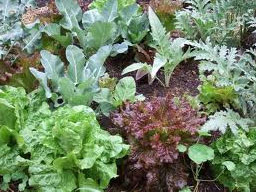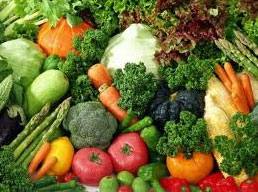 Contrary to what most people think, providing the necessary oxygen for life is not the only function of leaves. A significant part of what we eat, drink and inhale is also produced by leaves. The vegetables whose leaves and stalks we eat and the beverages with various aromas and flavors, steeped from dried leaves that we drink are important parts of our daily diets. In addition to being a food source containing vitamins such as C, A, thiamine, niacin, and folic acid, leafy vegetables offer varying amounts of minerals such as calcium, phosphorus, iron, sodium and potassium. Enriched with the fiber in their structure, and containing little fat and few calories, vegetables are specially created for a healthy human diet. That is why doctors regard the consumption of fruit and vegetables as essential for good health. As blessings created for human beings, many of the plants found in nature contain substances used in the treatment of various ailments, from headaches to cancer.
Contrary to what most people think, providing the necessary oxygen for life is not the only function of leaves. A significant part of what we eat, drink and inhale is also produced by leaves. The vegetables whose leaves and stalks we eat and the beverages with various aromas and flavors, steeped from dried leaves that we drink are important parts of our daily diets. In addition to being a food source containing vitamins such as C, A, thiamine, niacin, and folic acid, leafy vegetables offer varying amounts of minerals such as calcium, phosphorus, iron, sodium and potassium. Enriched with the fiber in their structure, and containing little fat and few calories, vegetables are specially created for a healthy human diet. That is why doctors regard the consumption of fruit and vegetables as essential for good health. As blessings created for human beings, many of the plants found in nature contain substances used in the treatment of various ailments, from headaches to cancer.
Some 20 amino acids serve as building blocks in the human body. The body is unable to synthesize eight of these on its own, for which reason they have to be absorbed through the foods we eat. All vegetables contain these amino acids in varying degrees. With their structures specially created for the human body, these plants have no side effects and do no harm when consumed properly. They merely bestow health and meet our dietary needs.
The leaves we eat every day, the flowers that adorn our tables and delight us with their appearance, have been specially created, both in terms of shape and flavor. The rich leaves in vegetables such as cabbage (Brassica oleracea), for example, retain their freshness for long periods. Even if the outer leaves wilt, it takes a long time for the inner ones to do so. There are large quantities of calcium and Vitamins A, C, B1, B2 and B12 in such plants. In addition they contain carbohydrate, cellulose, protein and useful salts that are essential for human body also they are low in calories. Another example of the healthful leaves that we eat is spinach, which contains high levels of Vitamins A, B1, B2, C and K, substances such as proteins and cellulose, and large quantities of iron. No matter which vegetable one takes as an example—chard, purslane, lettuce, artichoke, cauliflower or broccoli—all are marvels of design with their shapes, ease of cultivation and nutrient-storage capacity. In addition, each one is a nutritional blessing with its characteristic flavors and contents that have been specially created for human beings.
Another example of the healthful leaves that we eat is spinach, which contains high levels of Vitamins A, B1, B2, C and K, substances such as proteins and cellulose, and large quantities of iron. No matter which vegetable one takes as an example—chard, purslane, lettuce, artichoke, cauliflower or broccoli—all are marvels of design with their shapes, ease of cultivation and nutrient-storage capacity. In addition, each one is a nutritional blessing with its characteristic flavors and contents that have been specially created for human beings.
Along with these vegetables we eat, there are also leaves we use to add flavors to whatever we eat and drink. A large number of these leaves serve as special natural medicines created for us by Allah. For instance, parsley is one of these, rich in vitamins, especially Vitamin C. Thyme is another scented dried leaf which has been used very often against various ailments and infectious diseases since very ancient times.
Modern research has shown that thyme is an antiseptic, whose oil is a powerful germ killer. Thyme oil, known as thymol, is widely employed in the manufacture of drugs. In addition to its other nutritional properties, thyme is used in the treatment of flu, colds and angina, as well as improving the appetites of sick children and as a restorative for convalescents. There are so many therapeutic herbs—including bay, basil, tarragon, dill, marjoram and mint—that encyclopedias on the subject mention more than a thousand varieties of such plants and their superior properties. These plants, which are recently being re-evaluated, are being used in the search for cures for a variety of diseases from cancer to rheumatism, from skin disorders to hoarseness.
There are so many therapeutic herbs—including bay, basil, tarragon, dill, marjoram and mint—that encyclopedias on the subject mention more than a thousand varieties of such plants and their superior properties. These plants, which are recently being re-evaluated, are being used in the search for cures for a variety of diseases from cancer to rheumatism, from skin disorders to hoarseness.
Leaves whose teas we drink, such as sage, camomile and bergamot, are among these plants used not just for their taste, but for their therapeutic health-giving properties. For example, sage has the Latin name of Salvia salvatrix, or life-saving herb. This plant, used as an antiseptic, soothes and prevents night sweats, flu, nervous disorders and tension.
Plants’ health-giving properties are the clearest evidence that Allah created them as a blessing for human beings. The fact that a nutrient can be eaten; stores substances that benefit only human beings; can be grown abundantly, widely and easily enough to serve all of mankind, who need not labor too hard to enjoy all its benefits are some of Allah’s great miracles. In the Qur’an, Allah reveals this blessing to thinking people:
It is He Who created you. Yet among you are those who are disbelievers and those who are believers. Allah sees what you do. He created the heavens and the earth with truth and formed you, giving you the best of forms. And He is your final destination. He knows everything in the heavens and earth. He knows what you keep secret and what you divulge. Allah knows what the heart contains. (Surat at-Taghabun: 2-4)


